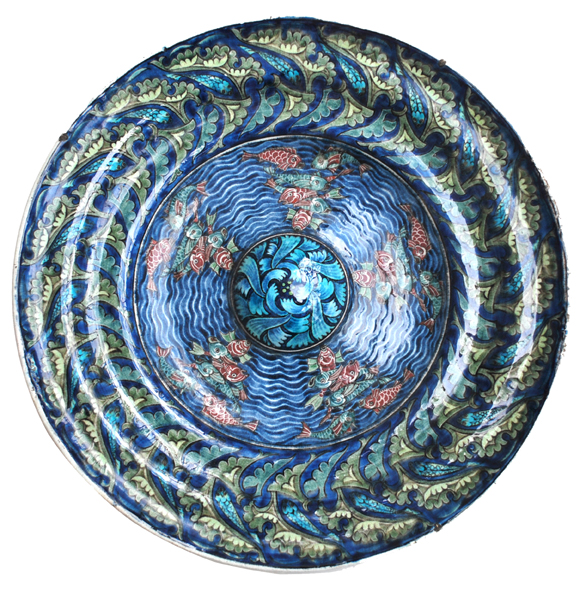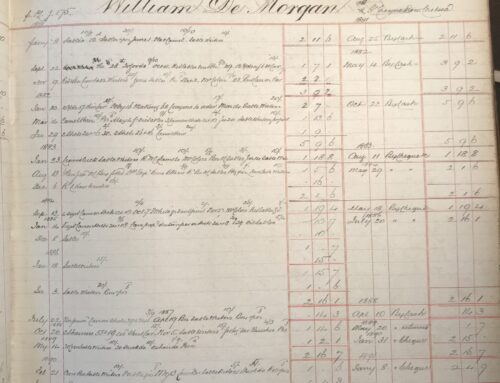
There is nothing more I enjoy doing than sitting in a museum or gallery sketching an object, artifact, or painting. During Covid-19 lockdown this is not possible, but the De Morgan Collection has a fantastic online collection where you can see images of all of the artworks. My favourite at the Watts Gallery, where I volunteer, is the Fish and Petal Rice Dish (1888-1907).
Every item in a museum or gallery’s collection each has its very own story, but I find the best way to really ‘see’ and object is by sketching it. For this blog post the De Morgan’s collection curator asked me to talk about my favourite piece, I knew instantly from the De Morgan talks that I deliver in normal circumstances, mine would be the rice dish. Like a lot of artists, William was not very inventive when naming his work. In fact, it was more of a simplistic description for instance the Fish and Petal Rice Dish, from the title you would expect to see petals and fish on a dish. But with all of De Morgan’s pieces there is always more to it than that. When I look at his ceramics, I am always blown away by how intertwined the shape and decoration complement each other so beautifully and skilfully. The bump in the centre is hollow on the reverse, it is the traditional shape of a middle eastern dish which ensures the rice stays warm and fluffy. It also makes the dish an aesthetically pleasing shape which is why De Morgan chose it. The Fish and Petal Rice Dish has been thrown beautifully with its undulating curves that replicate the ripples of a pool, the movement of water is further emphasised by the blue wiggly lines and vibrantly painted fish swimming around.
You will see in my sketch that I have used the photograph online to sketch from, but with all photographs they flatten the image. Bearing this in mind I decided to use a compass to draw each ‘ripple’ as a circle recreating the dish in a two-dimensional manner. From previous experience of sketching De Morgan designs, I knew this one would be deceptively complex, but with pleasurably flowing lines.
![20200504_111259[1]](https://www.demorgan.org.uk/wp-content/uploads/2020/05/20200504_1112591-scaled.jpg)
De Morgan did not fail to surprise me this time, just as he has previously when I have come to sketch a design. I have looked at this particular dish many times, but I had failed to notice that all the way around the outer rim, twenty turquoise blue fish swim delightfully between the petals, that look to me as if they are gently swaying pond plants. The movement created by these fish and plant life add to the overall aesthetic of this piece. When I had looked before I thought that the only fish were the ones near to the centre and that there were only a few orange fish darting in and out of the foliage. It was not until I was sketching that I could clearly see five groups of six brightly coloured orange and turquoise fish dancing around each other as if in a feeding frenzy. William De Morgan does not just capture the flipping of their fins and curvature of their bodies he manages to give each fish its own personality, which I found exceedingly difficult to capture. I would not dream of trying to copy his masterful creation, especially as my aim was to look more closely at his design in an attempt to discover his process and discover the finer detail, so my decision was to sketch out just a small section of the design. I worked from the centre, where I discovered a previously missed feature, small yellow dots as though they make up the centre of a flower head. I worked my way up towards the group of fish, noticing all the different angles and poses William had captured them in, I decided to move the two fish on the outer edges of huddle down lower so that I could concentrate on them fully, as I had no intention of recreating the dish as a whole. Then working my way up to the outer rim, the turquoise fish was such a jolly fellow darting in and out of, as I discovered a complex ‘petal’. The outer rim has different shades of blue, turquoise, and greens, although I am not a ceramicist with my limited experience, I can appreciate the skill that has gone into being able to achieve such depth and range of colours.
I chose to use pencils rather than paints, even though I was at home I wanted to place myself in the virtual position of being within the confines of a gallery and within that environment I would not be able to take paints. I would normally have with me a very small kit comprising of a small A5 sketchbook and a 2B and 4B pencil, I did however for this exercise allow myself some colours using pencils as I figured I could probably be able to use those in any gallery and I didn’t feel I would do any justice to William De Morgan’s Iznik inspired colour palette with graphite alone. I am also trying to improve my skills with coloured pencils at the moment so grab any opportunity to use them that I can. As with the other opportunities to sketch a De Morgan design I found it a pleasurable uplifting experience as well as a voyage of discovery. The longer I study each of William De Morgan’s ceramics the more there is to learn and discover and enjoy, I am always left with the sense of admiration for his skill and ability to create pieces of art that complement the form and vice versa, it is not surprising that his aesthetic style was and is so popular.
Try drawing a De Morgan ceramic for yourself, and share your pictures with us on Facebook and Instagram @demorganfoundation on Twitter @demorganf and use the hashtag #demorgan






